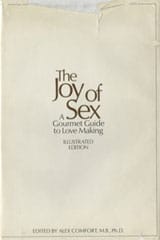"The Joy of Sex" and "Our Bodies, Ourselves": Mmm Mmm Good
By Christine Cupaiuolo — January 5, 2009
 We’re only five days into 2009, but I’m hedging my bets that Ariel Levy’s article in The New Yorker on the new edition of “The Joy of Sex” will be among the most memorable writing of the year.
We’re only five days into 2009, but I’m hedging my bets that Ariel Levy’s article in The New Yorker on the new edition of “The Joy of Sex” will be among the most memorable writing of the year.
For starters, Levy does a good job of introducing readers to the original author, British scientist and physician Alex Comfort (who died in 2000), and contextualizing attitudes toward sex and sexuality that framed the original book’s release in 1972.
Her descriptions are spot-on, including her humorous impression of the book’s famous illustrations and its hairy male star:
The woman depicted in these drawings is lovely, and, even nearly forty years later, quite chic. Her gentleman friend, however, looks like a werewolf with a hangover. He is heavily bearded; his hair is long, and, it always seemed, a little greasy. His eyelids are usually at half-mast, adding to his feral appearance. In some of the pictures, you can practically smell him. (The smell is unpleasant.)
There are other reasons to love this article. As Levy notes, “The Joy of Sex” wasn’t the only book released in the early 70s that offered a frank, sex-positive perspective. There was also “Our Bodies, Ourselves”:
The book announced on its original, 1971 jacket that it was “By and for Women,” and with its democratic inclusion of numerous voices it had the vibe of a consciousness-raising group. (In fact, it was the product of one.) “Our Bodies, Ourselves” covered much of the same material as “The Joy of Sex,” just with a different tone. It, too, had illustrations of a hirsute couple having intercourse in a series of positions. Both books said that everybody was bisexual, that sex should be a mutually satisfying, full-body experience, and that the communication of turn-ons could be of great benefit to this enterprise. And both books espoused the (distinctly seventies) notion that sex could be a value-neutral experience, as natural as eating, which undermined the traditional belief that sex ought to be in the service of procreation within the bounds of matrimony. “Our Bodies, Ourselves” added information on health, nutrition, self-defense, childbearing, and a rather more involved section on lesbianism. (“The Joy of Sex” has a drawing of two naked ladies kissing under the heading “Bisexuality,” while “Our Bodies, Ourselves” includes a chapter entitled “In Amerika They Call Us Dykes.”) If “The Joy of Sex” was like “Joy of Cooking” — though in some ways it was closer to Julia Child’s “Mastering the Art of French Cooking,” what with its strong authorial voice and affection for elaborate undertakings, to which Comfort assigned French names like pattes d’araignée, cuissade, and feuille de rose — “Our Bodies, Ourselves” was like the “Moosewood Cookbook.” Everything in it was healthful, enlightened, nourishing.
And here’s the part that made this non-meat eater burst out laughing:
Here’s a trick you might try at home sometime: pick almost any recipe in the “Moosewood.” Now add bacon. You will find that the addition of this decidedly unwholesome ingredient makes the food taste much better. “Our Bodies, Ourselves,” likewise, lacked a certain trayf allure. The revised edition of the book — even the original — is a fantastic resource for educating young women (and very sophisticated girls) about their physicality. But as an erotic reference for adults in 2008 it’s a little vegan.
I’ll pass on the bacon, but go read the full article. There’s also a slideshow of illustrations comparing the original “The Joy of Sex” and the new “ultimate revised edition” (the British version was published in September; it will be released in American bookstores this month). And you can listen to Levy talk about how society has changed since the book’s release and whether the new revised edition still fulfills a need.
Plus: The New York Times also recently wrote about the updated “The Joy of Sex” and talked with its author, Susan Quilliam, a British sexologist, advice columnist and relationship counselor. Some of the changes discussed:
“He had a section on tactful ways to take a woman’s virginity,” Ms. Quilliam said. “He had a section called ‘frigidity.’ I’m sure he was a lovely man, but he said that most men, given a young and attractive partner, can always get it up — it’s only when a woman lets herself go that he has a problem. And you’re going, ‘No, no, no!’ But that is what it was like then.”
Dr. Comfort said, too, that another part of the female genitalia, the vulva, was “slightly scary” to many males. Ms. Quilliam’s version has replaced his passages with some suggestions on the proper erotic care and treatment of a vulva and the observation that its image has been “beautifully immortalized in feminist artist Judy Chicago’s exhibition, ‘The Dinner Party’. ”

Loved this post (I hadn’t read the article in The New Yorker). The images of hairy men and bacon that it conjured up are priceless 😉
Molly
What a blast from the past. I used to sneak that Joy Of Sex book out of my parent’s closet and thinking that sex must be quite a hairy ordeal. “Our Bodies, Ourselves” wasn’t really a book you’d find in the suburbs at the time but you would occasionally find it at friend’s houses that smelled like Patchouli and weed. Those were the days..